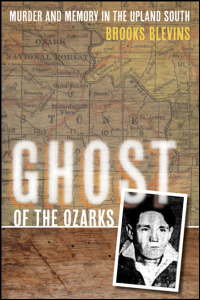 In 1929 a drifter named Connie Franklin was killed in the Arkansas Ozarks and his teenage fiancé was raped. Five local men were arrested for the crimes. On the eve of the murder trial, the dead man reappeared to testify on behalf of the accused. Brooks Blevins, the Noel Boyd Professor of Ozarks Studies at Missouri State University, answered our questions about his new book Ghost of the Ozarks: Murder and Memory in the Upland South.
In 1929 a drifter named Connie Franklin was killed in the Arkansas Ozarks and his teenage fiancé was raped. Five local men were arrested for the crimes. On the eve of the murder trial, the dead man reappeared to testify on behalf of the accused. Brooks Blevins, the Noel Boyd Professor of Ozarks Studies at Missouri State University, answered our questions about his new book Ghost of the Ozarks: Murder and Memory in the Upland South.
Q: Who is the “Ghost” in the book’s title?
Blevins: The “Ghost of the Ozarks” was one of several nicknames the press gave to the man, Connie Franklin, who testified as the trial for his own murder and who may or may not have been an imposter.
Q: How and when did the murder victim, the “Ghost” of the Ozarks, appear to testify?
Blevins: A traveling phonograph salesman discovered the “Ghost” working on a farm in the Arkansas Delta about ten days before the trial was to commence and convinced him to turn himself in to authorities more than 100 miles away in the Ozarks.
Q: How was his testimony perceived?
Blevins: It depended on who was doing the perceiving. Relatives and friends of the five men accused of the murder of Connie Franklin were, not surprisingly, excited to see him and eagerly proclaimed him the “real” Connie Franklin, while relatives and friends of the accuser (teenaged girl Tiller Ruminer) dismissed the “Ghost” as an imposter and considered his testimony useless at best and part of an elaborate conspiracy at worst.
Q: Did this event garner much national media attention?
Blevins: The story of the murder of Connie Franklin and the hobo who claimed to be the murdered man dominated state and regional news for the better part of a month between Thanksgiving and Christmas in 1929, regularly appearing on front pages and in pictorial spreads in daily papers in Kansas City, St. Louis, and Memphis. It also received significant media attention around the nation, with the more sensational wire stories making front-page headlines in daily papers large and small from coast to coast. Two different issues of TIME carried brief articles on the murder story. As a matter of fact, I first came across the story while looking through an old copy of TIME.
 Q: What about this rural region attributed to how this story was perceived nationwide?
Q: What about this rural region attributed to how this story was perceived nationwide?
Blevins: Stereotypes of the rural Ozarks and of people in the highland South in general were well established by 1929. Most of the characteristics attributed to these “hillbillies” are familiar to readers today: illiteracy, slovenliness, moonshining, inbreeding, violence, backwardness, etc. Reporters, especially urban newsmen from places like Kansas City and Memphis, often crafted their stories with these stereotypes in mind, making the regional landscape one of the key characters in the saga.
Q: What kind of divisions did these murders create in the community?
Blevins: The chief division was between those who believed the “Ghost” to be the “real” Connie Franklin and those who believed him to be an imposter. These divisions within the community tended to break down along family lines, as people sided with relatives who were involved in the case on one side or the other. The possibility of imposture also caused
other Ozarkers and the reading public to come down on one side or the other. An informal survey conducted by one reporter showed that opinions were evenly split among those with no personal stake in the story.
Q: Do people in the region still talk about the murder to this day?
Blevins: It depends on where in the region and who’s doing the talking. For the most part the families of the accused and the accusers exercised an informal gag order that stifled discussion of the case in the years after 1929, so much so that direct descendants of some of the story’s central characters learned about the murder mystery only as young adults and through incidental brushes with the story. Two different descendants told me
that they first heard of the story when they happened across a version of it in a “true crime” serial or magazine years later. And it has been rare for these descendants to discuss the event with anyone not in the family or not from the immediate community. Outside of the immediate community and the families most initimately involved, the story survived in myriad versions among people who grew up in the White River valley. I suppose my family lived too far from the river, for I never heard the folklore of Connie Franklin.
Q: What’s the most interesting thing that you learned while researching the book?
Blevins: Just how relevant and emotional a story could remain after more than eighty years. As someone who had primarily written social history before this book, I was excited to write narrative history about a specific event but unprepared for the strong emotions stirred up by my poking into a story that many descendants and community residents felt was better left alone. Several people refused to discuss the event with me, but I was also fortunate to meet a number of interesting, helpful Ozarkers during my years of research. I felt a special obligation to them to recreate the events of 1929 as accurately as possible and to be fair to all the characters involved in a most remarkable story.
*****
Brooks Blevins author photo by Tim Ellis-Darkroom Studio.
